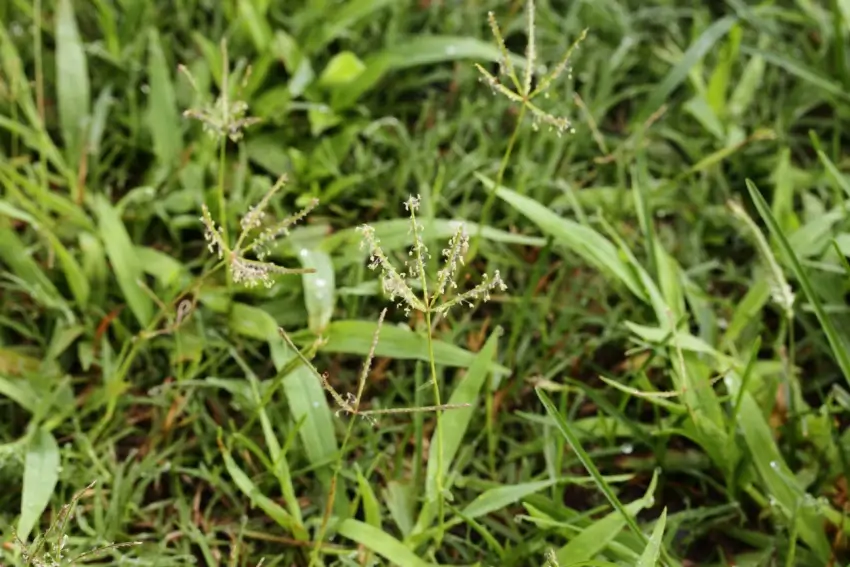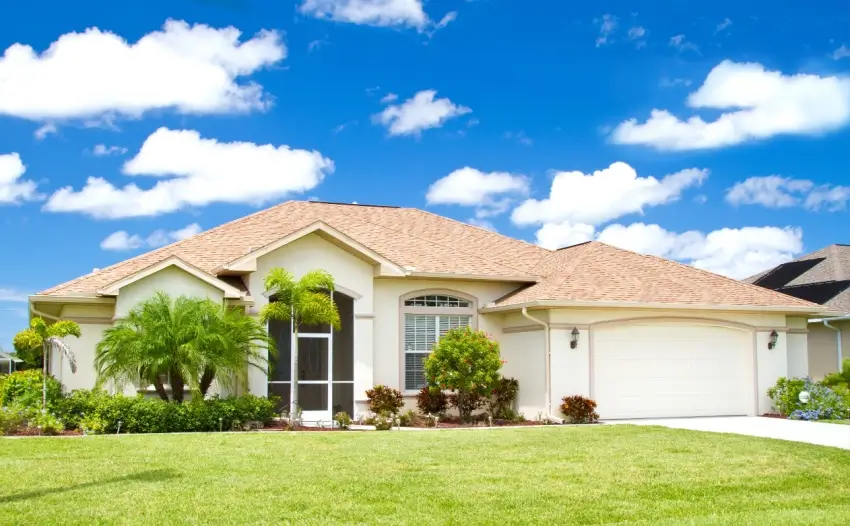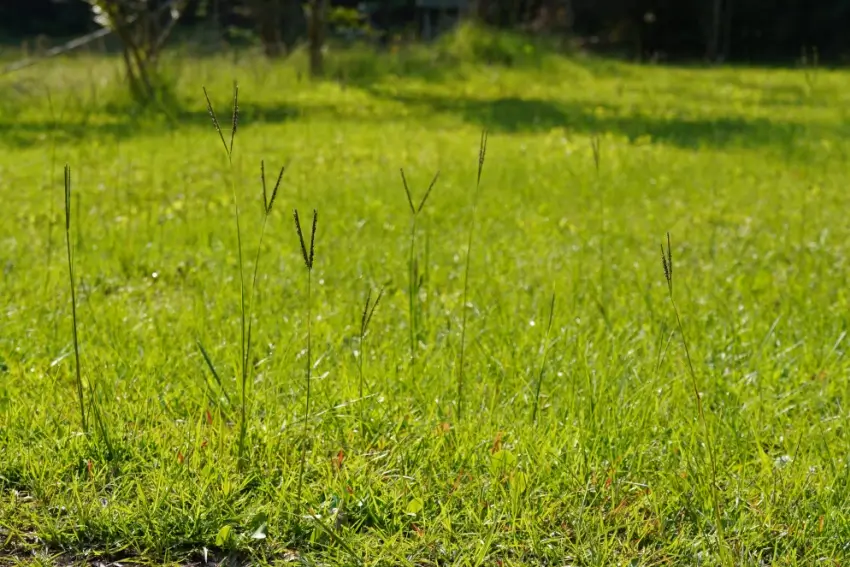Bahia Grass Lawns: Everything You Need to Know

Keeping your lawn alive and healthy can be challenging, especially in regions with sandy, acidic soil and hot, humid climates. Fortunately, one type of grass seems tailor-made for these tough conditions: Bahia grass.
What is Bahia grass, and could it be the solution to your Gulf Coast lawn woes?
Table of Contents:
What Is Bahia Grass?
Bahia grass lawns won’t be winning any yard beauty contests, but they are among the few types of grass that can survive in challenging climates.
Native to South America, Bahia grass is prized for its low maintenance needs and high drought tolerance. Its slow growth and clumping nature create a coarse-textured lawn. Although Bahia grass produces seed heads that will need occasional trimming, it remains an ideal choice for large lawns and pastures with plenty of direct sunlight and minimal foot traffic.
Types of Bahia Grass: Argentine vs. Pensacola
Two of the most common varieties of Bahia grass are Argentine and Pensacola. Both types of Bahia share many benefits, including good drought tolerance, adaptability to sandy soil, and low maintenance requirements.
However, the two varieties have distinct differences that set them apart.
Argentine Bahia Grass
Argentine Bahia grass has a finer leaf texture and a darker green shade than Pensacola does, resulting in a denser and more attractive lawn. Its cold tolerance makes it a versatile choice for various climates. Although it grows more slowly than Pensacola does, the wait is worth it for a softer and lush lawn.
Pensacola Bahia Grass
The biggest benefit of Pensacola is that it establishes quickly, making it a good choice for homeowners looking for fast and simple grass coverage to improve the appearance of a large lawn or field. While you will get a coarser texture with less density than with Argentine Bahia Grass, Pensacola’s reliability makes it a valuable option for many lawns.
Advantages of Choosing Bahia Grass for Your Lawn
Switching to a Bahia grass offers many advantages that makes it a popular choice:
Low Maintenance
Bahia grass requires less fertilizer, water, and overall maintenance than other common turf grasses do. Perfect for those who prefer to spend weekends enjoying their lawn rather than maintaining it, you will appreciate the relative ease of Bahia grass lawn care.
Good Drought Tolerance

Bahia grass is good at growing deep root systems that can suck up water from deep within the ground, even when things get dry on top. It can survive prolonged periods of drought—though it will turn brown and go dormant without consistent water, making it an excellent choice for areas with inconsistent rainfall.
Tolerates Sandy, Infertile Soils
Few grass varieties do well in sandy, acidic, or infertile soil. Bahia grass is one of a few options that will persevere where many other grasses struggle.
Resistant to Pests and Diseases
Bahia is also relatively resistant to many common diseases and pests that plague other turf varieties, including mole crickets, dollar spot, and leaf spot. This resilience means less pesticide and herbicide on your lawn.
How to Plant and Establish Bahia Grass
Looking to start your lawn over with Bahia grass? If you want instant results, you can purchase the grass as a sod. Proper lawn preparation and installation are essential for success. (We recommend that most homeowners hire professional sod installers.)
Alternatively, if you don’t mind waiting a few weeks for your lawn to fill out, you can seed your lawn. Seeding is a cost-effective option, especially for large lawns.
We recommend seeding Bahia grass in the early spring to give it as much time as possible to grow before the hot summer days arrive.
Maintaining Your Bahia Grass Lawn
While Bahia is known for its low maintenance needs, that does not mean you can just “seed it and forget it.” Your grass will reward you if you show consistent TLC through ongoing lawn care.
Mowing
Mow Bahia grass every other week, increasing to once a week in summer if needed. Keep an eye out for the appearance of seed heads. That’s a good indication that it’s time to mow again.
Watering
Watering will depend on how much natural rainfall your lawn receives. Bahia grass is drought tolerant, so a little water goes a long way. Water more deeply and infrequently to encourage deep root growth. (Light watering leads to shallow roots.) If you notice your grass beginning to turn yellow or brown, it’s a sign to water more.
Fertilization
Start with a soil test to help determine how much fertilization your lawn needs. You can pick up a consumer soil test at most lawn care and home improvement stores. Generally, it’s a good idea to fertilize your lawn at least once a year. While Bahia grass does not need as much nutrition as many other types of grasses do, you may need to fertilize more often if your soil is particularly sandy or nutrient-poor.
Common Challenges and Solutions for Bahia Grass
Bahia grass is a relatively resilient variety of turf grass, but it still comes with its own challenges.
Seed Heads

Bahia grass produces tall seed heads, which can make your lawn look unkempt. The simplest solution is to regularly mow your lawn down to three or four inches in height to prevent the growth of seed heads. Alternatively, mowing after seed heads appear helps naturally overseed your lawn.
Weeds
Bahia grass’s less dense growth can leave room for weeds such as broadleaf and sedges. Applying a pre-emergent herbicide in spring helps prevent weeds. Spot-treat the areas with a post-emergent herbicide can manage any weeds that appear.
Poor Shade Tolerance
Bahia grass needs direct sunlight throughout the day to thrive. While it tolerates some shade, it can become thin or patchy in partially or fully shaded areas. If you have high-shade areas of your lawn, consider planting a shade-loving alternate ground cover, such as hostas, pachysandra, liriope, or ajuga.
Poor Tolerance for Foot Traffic
Do you have children or pets that love to romp and play on the grass? Unfortunately, Bahia grass doesn’t do well with that kind of stress. Stick to planting Bahia in areas that do not see a lot of foot traffic.
Ready to Establish Your Bahia Grass Lawn?
Wondering whether Bahia grass is right for your lawn? Determining the correct grass requires a great deal of knowledge, and if not done correctly could lead to a number of problems.
Contact The Grounds Guys®. Our local teams are highly experienced in working with challenging soils. We can assess your soil and help you choose the best grass for your needs, preferences, and budget. Find your local The Grounds Guys team to request a free estimate today.
 Click to call
Click to call


